Human Resource Management : Solved Assignment
VerifiedAdded on 2021/06/14
|8
|2399
|60
AI Summary
Contribute Materials
Your contribution can guide someone’s learning journey. Share your
documents today.

Human Resource Management 1
Human Resource Management
Human Resource Management
Secure Best Marks with AI Grader
Need help grading? Try our AI Grader for instant feedback on your assignments.
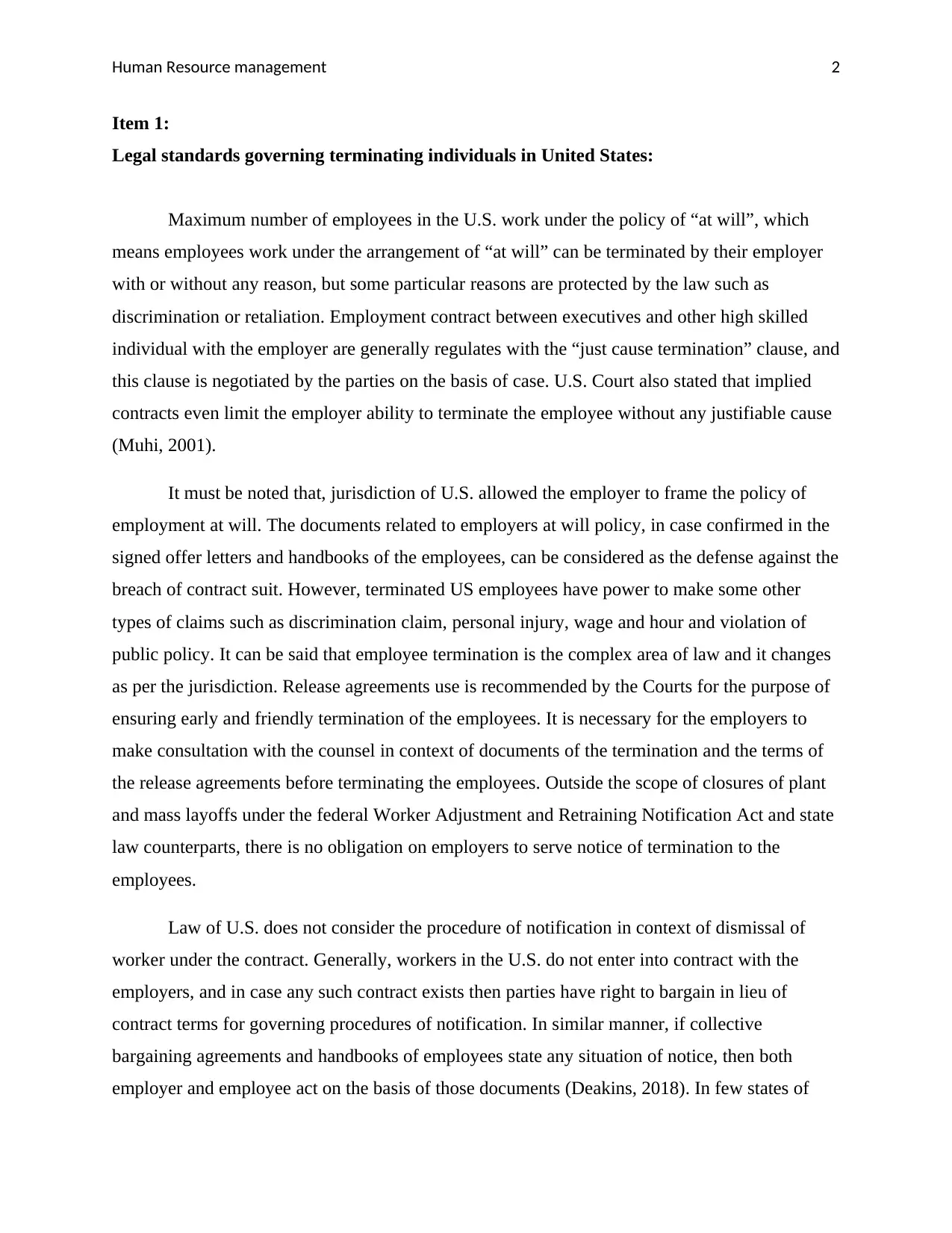
Human Resource management 2
Item 1:
Legal standards governing terminating individuals in United States:
Maximum number of employees in the U.S. work under the policy of “at will”, which
means employees work under the arrangement of “at will” can be terminated by their employer
with or without any reason, but some particular reasons are protected by the law such as
discrimination or retaliation. Employment contract between executives and other high skilled
individual with the employer are generally regulates with the “just cause termination” clause, and
this clause is negotiated by the parties on the basis of case. U.S. Court also stated that implied
contracts even limit the employer ability to terminate the employee without any justifiable cause
(Muhi, 2001).
It must be noted that, jurisdiction of U.S. allowed the employer to frame the policy of
employment at will. The documents related to employers at will policy, in case confirmed in the
signed offer letters and handbooks of the employees, can be considered as the defense against the
breach of contract suit. However, terminated US employees have power to make some other
types of claims such as discrimination claim, personal injury, wage and hour and violation of
public policy. It can be said that employee termination is the complex area of law and it changes
as per the jurisdiction. Release agreements use is recommended by the Courts for the purpose of
ensuring early and friendly termination of the employees. It is necessary for the employers to
make consultation with the counsel in context of documents of the termination and the terms of
the release agreements before terminating the employees. Outside the scope of closures of plant
and mass layoffs under the federal Worker Adjustment and Retraining Notification Act and state
law counterparts, there is no obligation on employers to serve notice of termination to the
employees.
Law of U.S. does not consider the procedure of notification in context of dismissal of
worker under the contract. Generally, workers in the U.S. do not enter into contract with the
employers, and in case any such contract exists then parties have right to bargain in lieu of
contract terms for governing procedures of notification. In similar manner, if collective
bargaining agreements and handbooks of employees state any situation of notice, then both
employer and employee act on the basis of those documents (Deakins, 2018). In few states of
Item 1:
Legal standards governing terminating individuals in United States:
Maximum number of employees in the U.S. work under the policy of “at will”, which
means employees work under the arrangement of “at will” can be terminated by their employer
with or without any reason, but some particular reasons are protected by the law such as
discrimination or retaliation. Employment contract between executives and other high skilled
individual with the employer are generally regulates with the “just cause termination” clause, and
this clause is negotiated by the parties on the basis of case. U.S. Court also stated that implied
contracts even limit the employer ability to terminate the employee without any justifiable cause
(Muhi, 2001).
It must be noted that, jurisdiction of U.S. allowed the employer to frame the policy of
employment at will. The documents related to employers at will policy, in case confirmed in the
signed offer letters and handbooks of the employees, can be considered as the defense against the
breach of contract suit. However, terminated US employees have power to make some other
types of claims such as discrimination claim, personal injury, wage and hour and violation of
public policy. It can be said that employee termination is the complex area of law and it changes
as per the jurisdiction. Release agreements use is recommended by the Courts for the purpose of
ensuring early and friendly termination of the employees. It is necessary for the employers to
make consultation with the counsel in context of documents of the termination and the terms of
the release agreements before terminating the employees. Outside the scope of closures of plant
and mass layoffs under the federal Worker Adjustment and Retraining Notification Act and state
law counterparts, there is no obligation on employers to serve notice of termination to the
employees.
Law of U.S. does not consider the procedure of notification in context of dismissal of
worker under the contract. Generally, workers in the U.S. do not enter into contract with the
employers, and in case any such contract exists then parties have right to bargain in lieu of
contract terms for governing procedures of notification. In similar manner, if collective
bargaining agreements and handbooks of employees state any situation of notice, then both
employer and employee act on the basis of those documents (Deakins, 2018). In few states of

Human Resource management 3
U.S., every worker, whether such worker is under contract or not has right to get service letter
which defines the reason because of which such person is terminated. Firstly, requires related to
service letter or reasons of the termination must be submitted by the worker. It must be noted
that, there is no Federal law which make the requirement of service letter compulsory. There is
no law which defines the tenure period of notice, which means how much time before notice
must be served to the employee in context of termination. However, tenure for notice in lieu of
collective bargaining agreements is between 60-90 days (OECD, 2013).
References:
Deakins, O. (2018). Employment & labor law in the USA. Retrieved on 4th may 2018
from: https://www.lexology.com/library/detail.aspx?g=9393a7bf-7b92-4212-8523-
2a1fdd979a2f.
Muhi, C. (2001). The employment-at-will doctrine: three major exceptions. Retrieved on
4th may 2018 from: https://www.bls.gov/opub/mlr/2001/01/art1full.pdf.
OECD, (2013). United States. Retrieved on 4th may 2018 from:
https://www.oecd.org/els/emp/United%20States.pdf.
Action Items 2:
Legal standards governing terminating individuals when downsizing:
There are number of companies which deal with the disagreeable task of terminating the
employee or group of employees for the reason of business downsizing. While doing this it is
necessary for them to deal and comply with the number of employees for different reasons such
as maintaining the morale of employees and reducing the risk of legal issues. Downsizing
happens when mass termination is done by the employer for the purpose of reducing the cost
(cutler, 2016). Generally, downsizing involves the permanent employee termination, but some
other methods are also there which can be used under this option:
U.S., every worker, whether such worker is under contract or not has right to get service letter
which defines the reason because of which such person is terminated. Firstly, requires related to
service letter or reasons of the termination must be submitted by the worker. It must be noted
that, there is no Federal law which make the requirement of service letter compulsory. There is
no law which defines the tenure period of notice, which means how much time before notice
must be served to the employee in context of termination. However, tenure for notice in lieu of
collective bargaining agreements is between 60-90 days (OECD, 2013).
References:
Deakins, O. (2018). Employment & labor law in the USA. Retrieved on 4th may 2018
from: https://www.lexology.com/library/detail.aspx?g=9393a7bf-7b92-4212-8523-
2a1fdd979a2f.
Muhi, C. (2001). The employment-at-will doctrine: three major exceptions. Retrieved on
4th may 2018 from: https://www.bls.gov/opub/mlr/2001/01/art1full.pdf.
OECD, (2013). United States. Retrieved on 4th may 2018 from:
https://www.oecd.org/els/emp/United%20States.pdf.
Action Items 2:
Legal standards governing terminating individuals when downsizing:
There are number of companies which deal with the disagreeable task of terminating the
employee or group of employees for the reason of business downsizing. While doing this it is
necessary for them to deal and comply with the number of employees for different reasons such
as maintaining the morale of employees and reducing the risk of legal issues. Downsizing
happens when mass termination is done by the employer for the purpose of reducing the cost
(cutler, 2016). Generally, downsizing involves the permanent employee termination, but some
other methods are also there which can be used under this option:
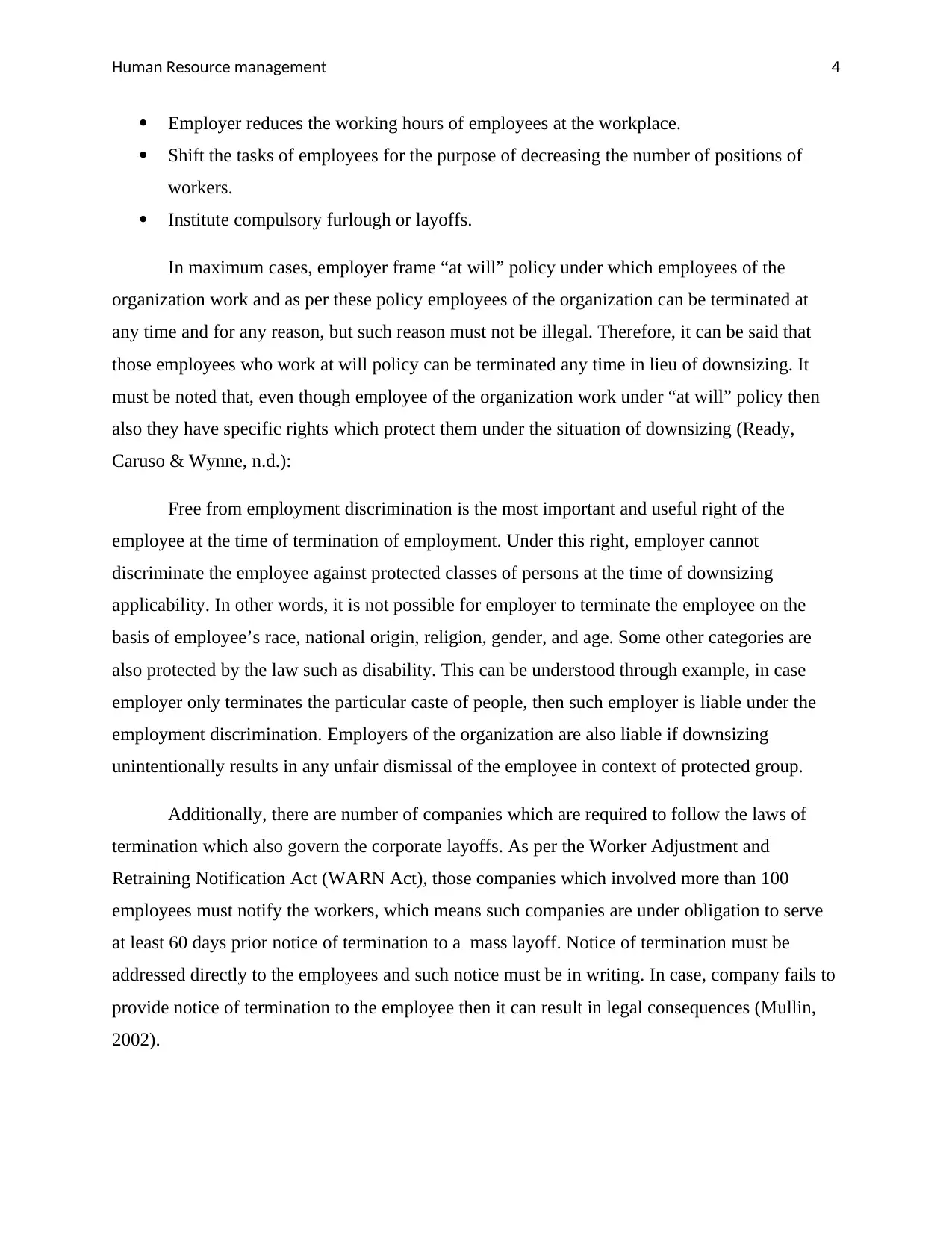
Human Resource management 4
Employer reduces the working hours of employees at the workplace.
Shift the tasks of employees for the purpose of decreasing the number of positions of
workers.
Institute compulsory furlough or layoffs.
In maximum cases, employer frame “at will” policy under which employees of the
organization work and as per these policy employees of the organization can be terminated at
any time and for any reason, but such reason must not be illegal. Therefore, it can be said that
those employees who work at will policy can be terminated any time in lieu of downsizing. It
must be noted that, even though employee of the organization work under “at will” policy then
also they have specific rights which protect them under the situation of downsizing (Ready,
Caruso & Wynne, n.d.):
Free from employment discrimination is the most important and useful right of the
employee at the time of termination of employment. Under this right, employer cannot
discriminate the employee against protected classes of persons at the time of downsizing
applicability. In other words, it is not possible for employer to terminate the employee on the
basis of employee’s race, national origin, religion, gender, and age. Some other categories are
also protected by the law such as disability. This can be understood through example, in case
employer only terminates the particular caste of people, then such employer is liable under the
employment discrimination. Employers of the organization are also liable if downsizing
unintentionally results in any unfair dismissal of the employee in context of protected group.
Additionally, there are number of companies which are required to follow the laws of
termination which also govern the corporate layoffs. As per the Worker Adjustment and
Retraining Notification Act (WARN Act), those companies which involved more than 100
employees must notify the workers, which means such companies are under obligation to serve
at least 60 days prior notice of termination to a mass layoff. Notice of termination must be
addressed directly to the employees and such notice must be in writing. In case, company fails to
provide notice of termination to the employee then it can result in legal consequences (Mullin,
2002).
Employer reduces the working hours of employees at the workplace.
Shift the tasks of employees for the purpose of decreasing the number of positions of
workers.
Institute compulsory furlough or layoffs.
In maximum cases, employer frame “at will” policy under which employees of the
organization work and as per these policy employees of the organization can be terminated at
any time and for any reason, but such reason must not be illegal. Therefore, it can be said that
those employees who work at will policy can be terminated any time in lieu of downsizing. It
must be noted that, even though employee of the organization work under “at will” policy then
also they have specific rights which protect them under the situation of downsizing (Ready,
Caruso & Wynne, n.d.):
Free from employment discrimination is the most important and useful right of the
employee at the time of termination of employment. Under this right, employer cannot
discriminate the employee against protected classes of persons at the time of downsizing
applicability. In other words, it is not possible for employer to terminate the employee on the
basis of employee’s race, national origin, religion, gender, and age. Some other categories are
also protected by the law such as disability. This can be understood through example, in case
employer only terminates the particular caste of people, then such employer is liable under the
employment discrimination. Employers of the organization are also liable if downsizing
unintentionally results in any unfair dismissal of the employee in context of protected group.
Additionally, there are number of companies which are required to follow the laws of
termination which also govern the corporate layoffs. As per the Worker Adjustment and
Retraining Notification Act (WARN Act), those companies which involved more than 100
employees must notify the workers, which means such companies are under obligation to serve
at least 60 days prior notice of termination to a mass layoff. Notice of termination must be
addressed directly to the employees and such notice must be in writing. In case, company fails to
provide notice of termination to the employee then it can result in legal consequences (Mullin,
2002).
Secure Best Marks with AI Grader
Need help grading? Try our AI Grader for instant feedback on your assignments.
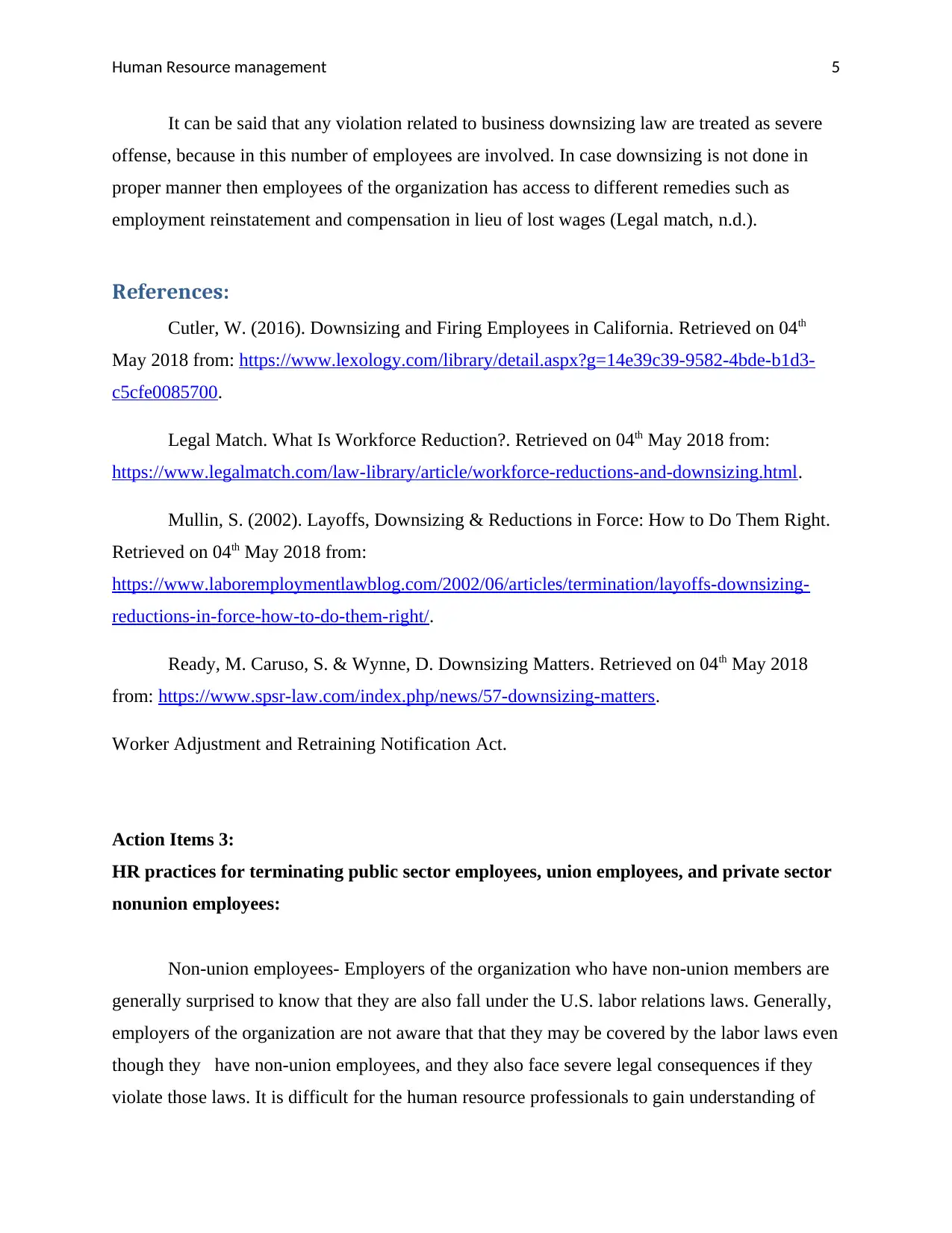
Human Resource management 5
It can be said that any violation related to business downsizing law are treated as severe
offense, because in this number of employees are involved. In case downsizing is not done in
proper manner then employees of the organization has access to different remedies such as
employment reinstatement and compensation in lieu of lost wages (Legal match, n.d.).
References:
Cutler, W. (2016). Downsizing and Firing Employees in California. Retrieved on 04th
May 2018 from: https://www.lexology.com/library/detail.aspx?g=14e39c39-9582-4bde-b1d3-
c5cfe0085700.
Legal Match. What Is Workforce Reduction?. Retrieved on 04th May 2018 from:
https://www.legalmatch.com/law-library/article/workforce-reductions-and-downsizing.html.
Mullin, S. (2002). Layoffs, Downsizing & Reductions in Force: How to Do Them Right.
Retrieved on 04th May 2018 from:
https://www.laboremploymentlawblog.com/2002/06/articles/termination/layoffs-downsizing-
reductions-in-force-how-to-do-them-right/.
Ready, M. Caruso, S. & Wynne, D. Downsizing Matters. Retrieved on 04th May 2018
from: https://www.spsr-law.com/index.php/news/57-downsizing-matters.
Worker Adjustment and Retraining Notification Act.
Action Items 3:
HR practices for terminating public sector employees, union employees, and private sector
nonunion employees:
Non-union employees- Employers of the organization who have non-union members are
generally surprised to know that they are also fall under the U.S. labor relations laws. Generally,
employers of the organization are not aware that that they may be covered by the labor laws even
though they have non-union employees, and they also face severe legal consequences if they
violate those laws. It is difficult for the human resource professionals to gain understanding of
It can be said that any violation related to business downsizing law are treated as severe
offense, because in this number of employees are involved. In case downsizing is not done in
proper manner then employees of the organization has access to different remedies such as
employment reinstatement and compensation in lieu of lost wages (Legal match, n.d.).
References:
Cutler, W. (2016). Downsizing and Firing Employees in California. Retrieved on 04th
May 2018 from: https://www.lexology.com/library/detail.aspx?g=14e39c39-9582-4bde-b1d3-
c5cfe0085700.
Legal Match. What Is Workforce Reduction?. Retrieved on 04th May 2018 from:
https://www.legalmatch.com/law-library/article/workforce-reductions-and-downsizing.html.
Mullin, S. (2002). Layoffs, Downsizing & Reductions in Force: How to Do Them Right.
Retrieved on 04th May 2018 from:
https://www.laboremploymentlawblog.com/2002/06/articles/termination/layoffs-downsizing-
reductions-in-force-how-to-do-them-right/.
Ready, M. Caruso, S. & Wynne, D. Downsizing Matters. Retrieved on 04th May 2018
from: https://www.spsr-law.com/index.php/news/57-downsizing-matters.
Worker Adjustment and Retraining Notification Act.
Action Items 3:
HR practices for terminating public sector employees, union employees, and private sector
nonunion employees:
Non-union employees- Employers of the organization who have non-union members are
generally surprised to know that they are also fall under the U.S. labor relations laws. Generally,
employers of the organization are not aware that that they may be covered by the labor laws even
though they have non-union employees, and they also face severe legal consequences if they
violate those laws. It is difficult for the human resource professionals to gain understanding of
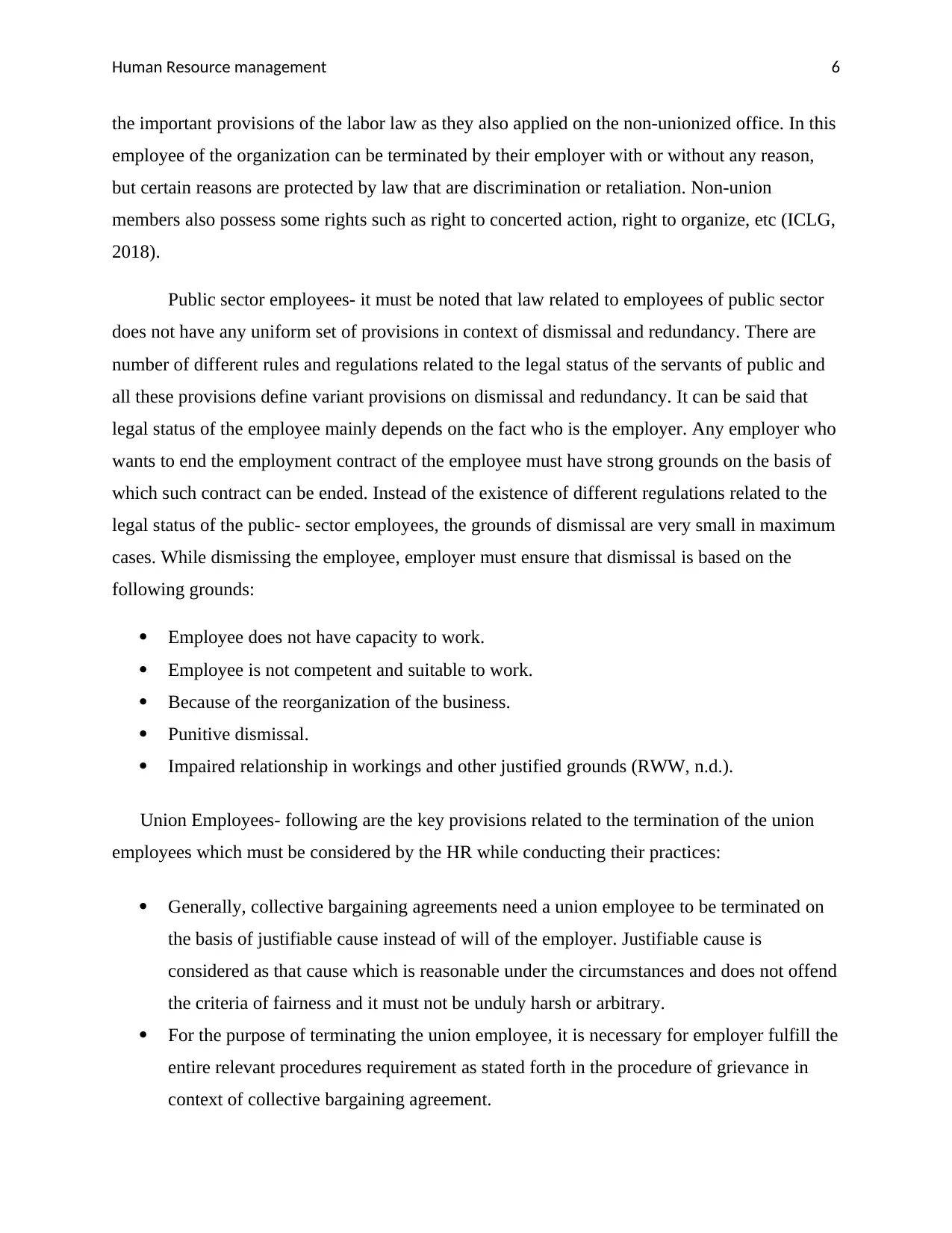
Human Resource management 6
the important provisions of the labor law as they also applied on the non-unionized office. In this
employee of the organization can be terminated by their employer with or without any reason,
but certain reasons are protected by law that are discrimination or retaliation. Non-union
members also possess some rights such as right to concerted action, right to organize, etc (ICLG,
2018).
Public sector employees- it must be noted that law related to employees of public sector
does not have any uniform set of provisions in context of dismissal and redundancy. There are
number of different rules and regulations related to the legal status of the servants of public and
all these provisions define variant provisions on dismissal and redundancy. It can be said that
legal status of the employee mainly depends on the fact who is the employer. Any employer who
wants to end the employment contract of the employee must have strong grounds on the basis of
which such contract can be ended. Instead of the existence of different regulations related to the
legal status of the public- sector employees, the grounds of dismissal are very small in maximum
cases. While dismissing the employee, employer must ensure that dismissal is based on the
following grounds:
Employee does not have capacity to work.
Employee is not competent and suitable to work.
Because of the reorganization of the business.
Punitive dismissal.
Impaired relationship in workings and other justified grounds (RWW, n.d.).
Union Employees- following are the key provisions related to the termination of the union
employees which must be considered by the HR while conducting their practices:
Generally, collective bargaining agreements need a union employee to be terminated on
the basis of justifiable cause instead of will of the employer. Justifiable cause is
considered as that cause which is reasonable under the circumstances and does not offend
the criteria of fairness and it must not be unduly harsh or arbitrary.
For the purpose of terminating the union employee, it is necessary for employer fulfill the
entire relevant procedures requirement as stated forth in the procedure of grievance in
context of collective bargaining agreement.
the important provisions of the labor law as they also applied on the non-unionized office. In this
employee of the organization can be terminated by their employer with or without any reason,
but certain reasons are protected by law that are discrimination or retaliation. Non-union
members also possess some rights such as right to concerted action, right to organize, etc (ICLG,
2018).
Public sector employees- it must be noted that law related to employees of public sector
does not have any uniform set of provisions in context of dismissal and redundancy. There are
number of different rules and regulations related to the legal status of the servants of public and
all these provisions define variant provisions on dismissal and redundancy. It can be said that
legal status of the employee mainly depends on the fact who is the employer. Any employer who
wants to end the employment contract of the employee must have strong grounds on the basis of
which such contract can be ended. Instead of the existence of different regulations related to the
legal status of the public- sector employees, the grounds of dismissal are very small in maximum
cases. While dismissing the employee, employer must ensure that dismissal is based on the
following grounds:
Employee does not have capacity to work.
Employee is not competent and suitable to work.
Because of the reorganization of the business.
Punitive dismissal.
Impaired relationship in workings and other justified grounds (RWW, n.d.).
Union Employees- following are the key provisions related to the termination of the union
employees which must be considered by the HR while conducting their practices:
Generally, collective bargaining agreements need a union employee to be terminated on
the basis of justifiable cause instead of will of the employer. Justifiable cause is
considered as that cause which is reasonable under the circumstances and does not offend
the criteria of fairness and it must not be unduly harsh or arbitrary.
For the purpose of terminating the union employee, it is necessary for employer fulfill the
entire relevant procedures requirement as stated forth in the procedure of grievance in
context of collective bargaining agreement.
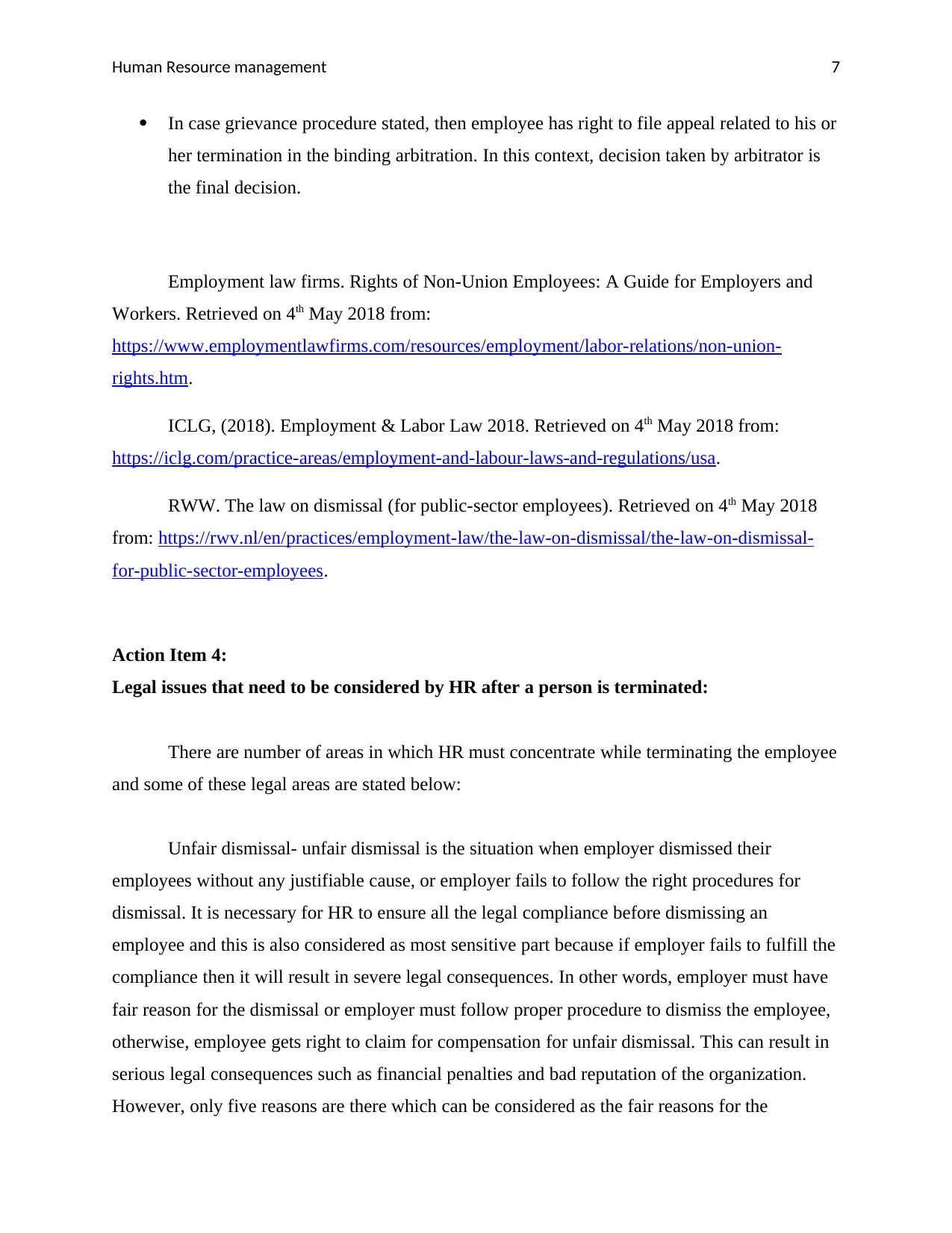
Human Resource management 7
In case grievance procedure stated, then employee has right to file appeal related to his or
her termination in the binding arbitration. In this context, decision taken by arbitrator is
the final decision.
Employment law firms. Rights of Non-Union Employees: A Guide for Employers and
Workers. Retrieved on 4th May 2018 from:
https://www.employmentlawfirms.com/resources/employment/labor-relations/non-union-
rights.htm.
ICLG, (2018). Employment & Labor Law 2018. Retrieved on 4th May 2018 from:
https://iclg.com/practice-areas/employment-and-labour-laws-and-regulations/usa.
RWW. The law on dismissal (for public-sector employees). Retrieved on 4th May 2018
from: https://rwv.nl/en/practices/employment-law/the-law-on-dismissal/the-law-on-dismissal-
for-public-sector-employees.
Action Item 4:
Legal issues that need to be considered by HR after a person is terminated:
There are number of areas in which HR must concentrate while terminating the employee
and some of these legal areas are stated below:
Unfair dismissal- unfair dismissal is the situation when employer dismissed their
employees without any justifiable cause, or employer fails to follow the right procedures for
dismissal. It is necessary for HR to ensure all the legal compliance before dismissing an
employee and this is also considered as most sensitive part because if employer fails to fulfill the
compliance then it will result in severe legal consequences. In other words, employer must have
fair reason for the dismissal or employer must follow proper procedure to dismiss the employee,
otherwise, employee gets right to claim for compensation for unfair dismissal. This can result in
serious legal consequences such as financial penalties and bad reputation of the organization.
However, only five reasons are there which can be considered as the fair reasons for the
In case grievance procedure stated, then employee has right to file appeal related to his or
her termination in the binding arbitration. In this context, decision taken by arbitrator is
the final decision.
Employment law firms. Rights of Non-Union Employees: A Guide for Employers and
Workers. Retrieved on 4th May 2018 from:
https://www.employmentlawfirms.com/resources/employment/labor-relations/non-union-
rights.htm.
ICLG, (2018). Employment & Labor Law 2018. Retrieved on 4th May 2018 from:
https://iclg.com/practice-areas/employment-and-labour-laws-and-regulations/usa.
RWW. The law on dismissal (for public-sector employees). Retrieved on 4th May 2018
from: https://rwv.nl/en/practices/employment-law/the-law-on-dismissal/the-law-on-dismissal-
for-public-sector-employees.
Action Item 4:
Legal issues that need to be considered by HR after a person is terminated:
There are number of areas in which HR must concentrate while terminating the employee
and some of these legal areas are stated below:
Unfair dismissal- unfair dismissal is the situation when employer dismissed their
employees without any justifiable cause, or employer fails to follow the right procedures for
dismissal. It is necessary for HR to ensure all the legal compliance before dismissing an
employee and this is also considered as most sensitive part because if employer fails to fulfill the
compliance then it will result in severe legal consequences. In other words, employer must have
fair reason for the dismissal or employer must follow proper procedure to dismiss the employee,
otherwise, employee gets right to claim for compensation for unfair dismissal. This can result in
serious legal consequences such as financial penalties and bad reputation of the organization.
However, only five reasons are there which can be considered as the fair reasons for the
Paraphrase This Document
Need a fresh take? Get an instant paraphrase of this document with our AI Paraphraser
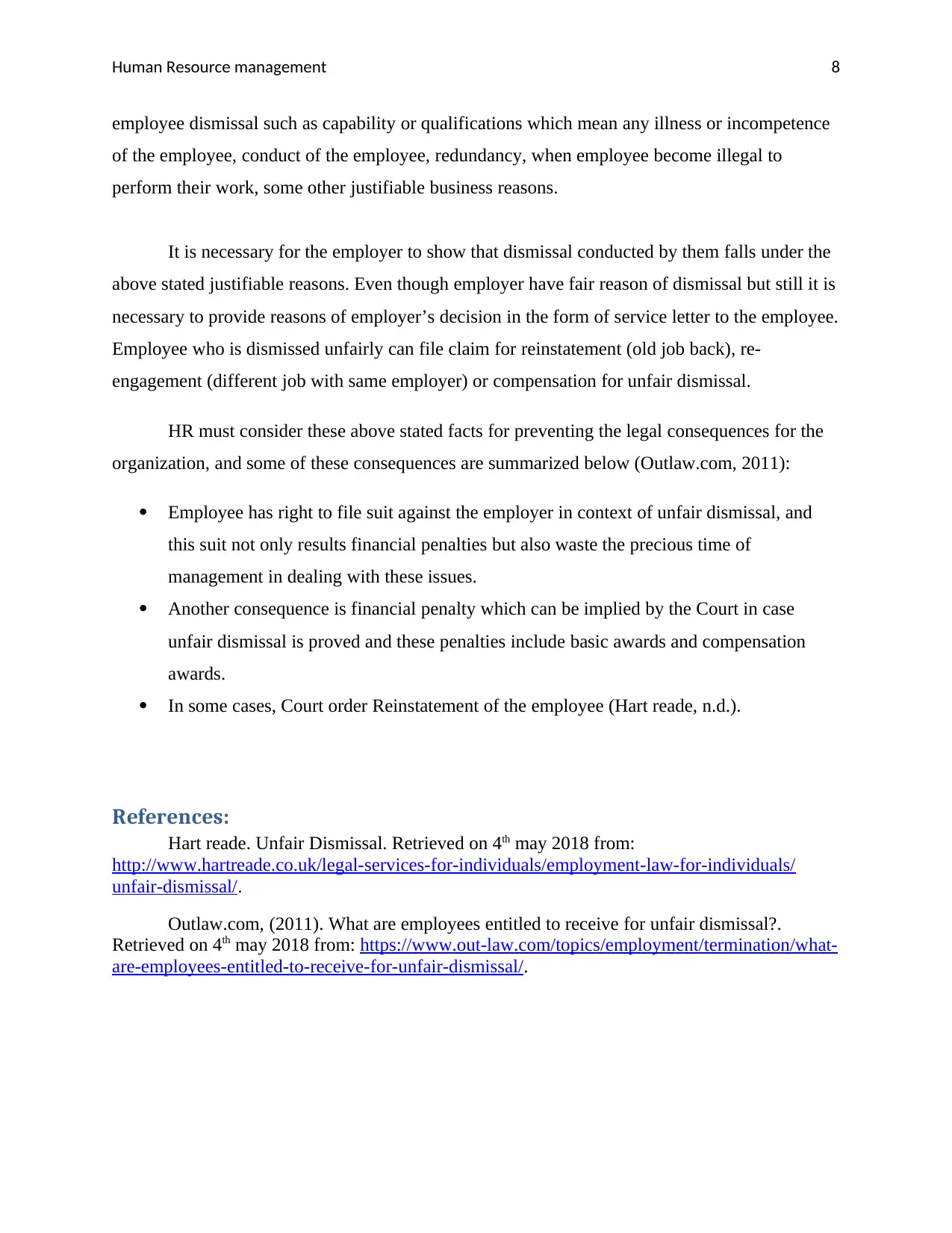
Human Resource management 8
employee dismissal such as capability or qualifications which mean any illness or incompetence
of the employee, conduct of the employee, redundancy, when employee become illegal to
perform their work, some other justifiable business reasons.
It is necessary for the employer to show that dismissal conducted by them falls under the
above stated justifiable reasons. Even though employer have fair reason of dismissal but still it is
necessary to provide reasons of employer’s decision in the form of service letter to the employee.
Employee who is dismissed unfairly can file claim for reinstatement (old job back), re-
engagement (different job with same employer) or compensation for unfair dismissal.
HR must consider these above stated facts for preventing the legal consequences for the
organization, and some of these consequences are summarized below (Outlaw.com, 2011):
Employee has right to file suit against the employer in context of unfair dismissal, and
this suit not only results financial penalties but also waste the precious time of
management in dealing with these issues.
Another consequence is financial penalty which can be implied by the Court in case
unfair dismissal is proved and these penalties include basic awards and compensation
awards.
In some cases, Court order Reinstatement of the employee (Hart reade, n.d.).
References:
Hart reade. Unfair Dismissal. Retrieved on 4th may 2018 from:
http://www.hartreade.co.uk/legal-services-for-individuals/employment-law-for-individuals/
unfair-dismissal/.
Outlaw.com, (2011). What are employees entitled to receive for unfair dismissal?.
Retrieved on 4th may 2018 from: https://www.out-law.com/topics/employment/termination/what-
are-employees-entitled-to-receive-for-unfair-dismissal/.
employee dismissal such as capability or qualifications which mean any illness or incompetence
of the employee, conduct of the employee, redundancy, when employee become illegal to
perform their work, some other justifiable business reasons.
It is necessary for the employer to show that dismissal conducted by them falls under the
above stated justifiable reasons. Even though employer have fair reason of dismissal but still it is
necessary to provide reasons of employer’s decision in the form of service letter to the employee.
Employee who is dismissed unfairly can file claim for reinstatement (old job back), re-
engagement (different job with same employer) or compensation for unfair dismissal.
HR must consider these above stated facts for preventing the legal consequences for the
organization, and some of these consequences are summarized below (Outlaw.com, 2011):
Employee has right to file suit against the employer in context of unfair dismissal, and
this suit not only results financial penalties but also waste the precious time of
management in dealing with these issues.
Another consequence is financial penalty which can be implied by the Court in case
unfair dismissal is proved and these penalties include basic awards and compensation
awards.
In some cases, Court order Reinstatement of the employee (Hart reade, n.d.).
References:
Hart reade. Unfair Dismissal. Retrieved on 4th may 2018 from:
http://www.hartreade.co.uk/legal-services-for-individuals/employment-law-for-individuals/
unfair-dismissal/.
Outlaw.com, (2011). What are employees entitled to receive for unfair dismissal?.
Retrieved on 4th may 2018 from: https://www.out-law.com/topics/employment/termination/what-
are-employees-entitled-to-receive-for-unfair-dismissal/.
1 out of 8
Related Documents
Your All-in-One AI-Powered Toolkit for Academic Success.
+13062052269
info@desklib.com
Available 24*7 on WhatsApp / Email
![[object Object]](/_next/static/media/star-bottom.7253800d.svg)
Unlock your academic potential
© 2024 | Zucol Services PVT LTD | All rights reserved.



